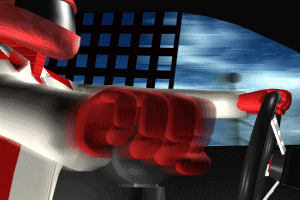 |
HANDLINGIn this section, we'll look at balance, suspension, and braking. |
 |
HANDLINGIn this section, we'll look at balance, suspension, and braking. |
UNDERSTEERING
Understeering happens when, in the same constant radius turn, the driver has to increase the steering angle as the car speeds up. When this happens, the car loses grip at the front tires first. This tendency causes the car to resist turning and continue in a straight line. On courses with sharp turns, this could result in your car not being able to make the turn in time, and you driving off the track or hitting a wall.
TIP: If your car is not taking the turns in time, you may want to adjust one or all of the following:
OVERSTEERING
This is used to describe the tendency of the car to lose grip at the rear of the car first. Oversteering makes the car tend to enter a spin, as your car's back end will slide out.
TIP: If your car tends to spin out as you take the corners, you may want to adjust one or all of the following:
BALANCE
What you'd really like is a balanced car - one that doesn't understeer or oversteer badly anywhere in the corner. This is only a racer's dream. This optimal setting will vary by the type of course you are driving. Since XCar features oval tracks, speedways, and road courses, you need to customize your car for the best balance on each track. You can study the Track Diagrams to determine where the trouble spots are on each course.
TIP: Actually, understeer is a more stable state than oversteer. A little understeer can help the driver know where the traction limit is with a margin of safety.
TIP: Jeff Braun, a full-time racecar engineer suggests: "I'm of the opinion that you always concentrate on the end that isn't working. If you have oversteer, you work on the back end. If you have undesteer, you work on the front end."
SUSPENSION
A car needs springs to isolate the drivers from road irregularities and weight transfer during changes in direction and speed. It's what links the car to the tires.
Aerodynamic forces affect springs. The heavier springs needed to support the weight of the car plus the extra downforce from aerodynamic devices degrades the mechanical grip the car produces. But, when another 10% downforce lowers lap times by seconds, compromises are gladly made.
SPRING RATE
If you put a 100 lbs. weight on a spring and it deflects 1 inch, then the spring is said to have a spring rate of 100 lbs. per inch. This is displayed as Rate under the suspension category in your Car Modification menu. Remember that aero forces increase as the square of the speed. So, forces at 120 mph are four times those at 60 mph.
TIP: To handle the extra aero load, you have to make your springs stiffer. If you have too much downforce pushing your car down and your suspension rate isn't high enough, the bottom of your car could scrape the road, thus slowing you down or throwing you into a spin.
DAMPERS
Dampers, also known as shock absorbers, are important because they dampen (absorb) suspension movement and weight transfer, improve passenger comfort, and provide a way to control the driver "feel" of the car. The driver reacts to car movements, and dampers control how that happens. In racecars that travel over 200 mph, the small bump on the road can feel like a swift kick in the pants. The best designed Spring/Damper systems allow the chassis, which is the body structure of the car, to remain relatively steady, and keeps the tires in contact with the ground despite bumps in the road and cornering forces. And as we have stressed so often, the more your tires are in contact with the road, the better overall performance of your car.
TIP: Dampers are transient devices, meaning that they are velocity sensitive. They don't do anything on straight smooth roads. They don't do anything after the car has settled into a turn. They don't do anything when a car is in a steady-state condition. Thus on tracks where there are long steady turns, like the Infinity Loop, dampers don't have as much influence.
TIP: For courses with bumps, or raised corners, you want to increase your dampers. You can think of the damper as a helper spring during bump.
ROLL BARS
The front and rear roll bars, also known as anti-roll bars, only affect the weight transferred while cornering. The stiffer the roll bar, the less weight is transferred. Since roll bars cause weight to be transferred from the loaded tire to the opposite unloaded tire, adjusting a roll bar should be considered adjusting the entire front or back of the car. Generally, increasing the stiffness of a roll bar at one end of the car will make that end looser.
ROLL ARM
The roll arm is the distance from the roll bar's connection point (to the frame) to the level arm's connection to the suspension. The roll arm affects the "stiffness" of the roll bars. Increasing the roll arm increases the stiffness.
BRAKING
All the high-tech cars that are available in XCar are equipped with ABS disc brakes. More information on the type of brakes to use will be available soon.